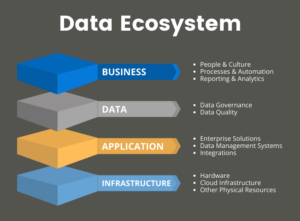Data Ecosystems 101: Understanding the Big Picture

Liz Murray
Director of Professional Services
When you think about data, you probably think about the information you capture and use as part of your job. For example, a gift processor would likely picture entering transactional data. A fundraiser might imagine a prospect pipeline or a gift chart.
Your data may have many homes—some formal, like a centralized database or data warehouse, and other more informal abodes such as spreadsheets, apps, and even in your brain. Your data may be shared with others or kept to yourself. Your organization may control and manage data with different levels of autonomy and coordination.
We often get so wrapped up in the details of how we individually use data that we don’t get a chance to take a step back and appreciate the big picture: We are part of a larger connected data ecosystem.
It’s important to understand this bigger picture, which I’ll explain more later. But first, let’s dive into the components that make up a data ecosystem.
What is a Data Ecosystem?
A data ecosystem is a conceptual model used to describe how people, data, and technology interact together as a coordinated system to achieve specific business strategies and outcomes.
Like a natural ecosystem, a data ecosystem consists of layers. These layers are business, data, application, and infrastructure. Let’s explore each of these.
- At the top of the ecosystem is the Business layer. This layer is comprised of your culture and your people. The processes and automations those people use are also encompassed in this layer.
- The Data layer nurtures your most important organizational asset: your data. Key components in this layer are data quality and data governance. Data quality refers to the accuracy, completeness, and timeliness of your organization’s information. Data governance refers to the authority, control, and shared decision-making within an organization around data management. Read more about data governance here.
- The Application layer provides a home for your data. Within this layer, we see enterprise solutions, data management systems, and integrations. Enterprise solutions are software applications designed to satisfy the needs of an organization rather than an individual end user. Data management systems help you extract value from your data by providing an organization-wide platform to unify and manage data (e.g., data warehouses and data lakes). Integrations allow data to flow across solutions and platforms as a connected information network.
- Finally, the Infrastructure layer includes the IT components required to physically support your data ecosystem, such as hardware, cloud infrastructure, networking, or other physical resources.

Understanding the Big Picture
So, why is it important to understand these layers? Because your organization’s data ecosystem doesn’t operate in a vacuum. Each layer within the ecosystem depends on every other layer, both directly and indirectly.
When you make a change in one area, you need to consider the big picture and the potential ripple effect of your actions. For example, a healthcare advancement team is connected to the greater data ecosystem of the hospital. They’re also connected to the external healthcare philanthropy sector biome. Any changes being considered for the healthcare advancement team need to be mindful of these connections.
To effectively manage your data ecosystem, you must be aware of both the individual system you’re using and the broader context of how that system is connected to the ecosystem.
Understanding the micro and macro environment is the first step in preparing your organization for a data-driven future, anticipating and responding to threats, and promoting organizational efficiency.
Modern organizations are complex environments comprised of many people, teams, departments, processes, and tools. We can help you see the big picture so you can effectively manage the data and systems within your larger ecosystem.
